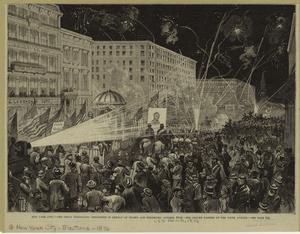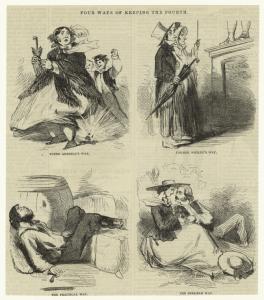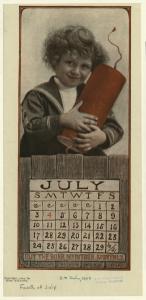
An image of New York City lit up by fireworks, 1876.
Courtesy New York Public Library.
Firecrackers are nothing new to Fourth of July celebrations. Early settlers used them to celebrate the signing of Declaration of Independence in 1777, and by 1800 the first advertisements for fireworks were published.

An image from Harper's Weekly, July 4, 1857
Courtesy New York Public Library.
The opinion about fireworks has changed drastically over the years. In a July 1871 issue of Harper’s Weekly, one writer proclaimed, “there is no use in protesting against the good old orthodox fashion of celebrating the fourth of July with bonfires, cannon, guns, pistols, rockets, fire-crackers, snakes, Roman candles, fire-balloons, and every other possible contrivance for making a blaze and a noise.” In July of 1894, just 23 years later, an anti-fireworks Harper’s Weekly article stated that these “methods of celebration are obsolete and barbarous.”
Fireworks were very hazardous when not properly handled (as they are today). On July 5, 1900 the New York Times recounted the previous day’s celebrations, noting several injuries due to fireworks. One article detailed how three women were riding in a horse-driven coach at Coney Island when boys startled the horse with firecrackers. The scared animal ran crazily on Surf Avenue, causing pedestrians to run out of the way, until the coachman caught the horse’s bridle and calmed it down. Thankfully no one was injured.
Unfortunately, some sad events happened did on this day. Nine-year-old Henry Schneider of Second Avenue was holding a firecracker when it randomly went off. His right hand was shattered and he lost his right eye, as it was “blown out.” Another article reported how seven-year-old Gustave Rosmarin of 70 First Street fell out of a window and died instantly. He was shooting off firecrackers on the window ledge when some boys on the street threw more up at him to set off. He was frightened, lost his balance and fell. [Read more.]
In a 1910 Harper’s Weekly article titled “Our Murderous Patriotism,” the writer detailed the injuries and deaths on or shortly after the Fourth of July. Here are the recorded numbers from 1903-1909:
901 deaths from tetanus
630 deaths from other causes, including fireworks
114 cases of complete blindness
518 losses of one eye
406 losses of legs, hands or arms
1,420 losses of one or more fingers
30,606 other various injuries
A grand total of 34,603 were either injured or dead in seven years of Fourth of July celebrations. The article did not say whether these figures were specific to the New York area, so they are probably national statistics. In a July 5, 1912 New York Times article, one orator proclaimed that “on one Fourth of July there were more people killed in New York than there were in the Battle of Lexington.”
By 1911 New York City was starting to change the way the holiday was celebrated. In a June 1911 Harper’s Weekly edition, an article titled “A Sane Fourth makes a Happy Fourth” detailed how the celebration would run that year. It read, “To assure an old-fashioned Fourth of July celebration in New York City, with a minimum of fireworks and a maximum of patriotic enthusiasm,” the city would focus on the “procession of the nations.” The article claimed that “every nationality in the borough will be represented” by one family marching and holding their homeland’s flag. It is interesting to see how the definition of “old-fashioned” changed from 1871 (when they felt it patriotic to use all kinds of explosives) to 1911.

This ad would never be published today...
Courtesy New York Public Library
In the late 20th century fireworks become illegal in many counties and states, usually because of safety concerns. But in 2007 New York City repealed its ban of firecrackers, and people enjoyed seeing 300,000 set off in Chinatown’s Chatham Square.
A happy and safe Fourth to all our readers!
-posted by Devin, with thanks to Mary Brown, the Stephen A. Schwarzman Building and the New York Public Library Digital Gallery


No comments:
Post a Comment
Note: Only a member of this blog may post a comment.